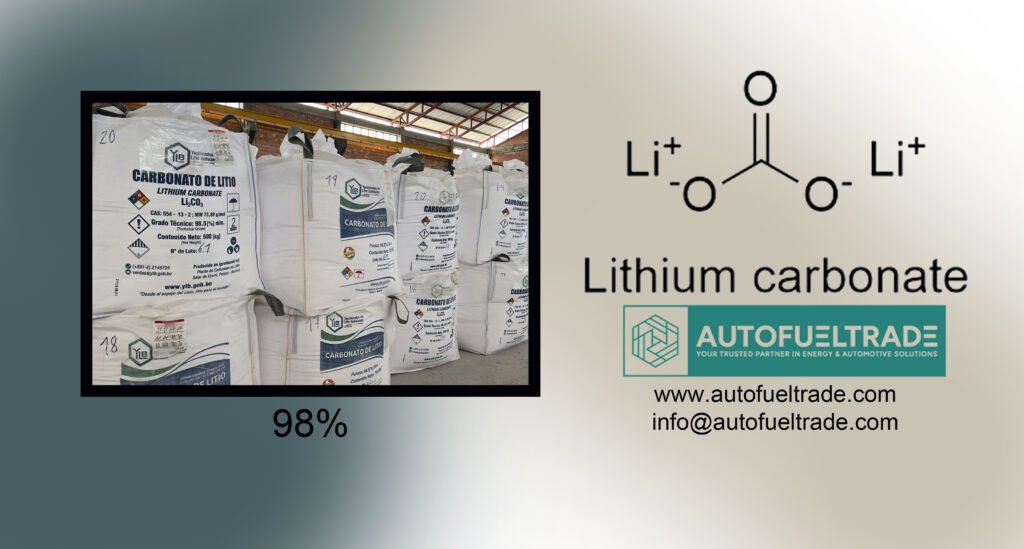
🔹 Description: Lithium Carbonate (Li₂CO₃) – 98% Purity
- Chemical Formula: Li₂CO₃
- Molecular Weight: 73.89 g/mol
- Appearance: White, odorless crystalline powder
- Purity: 98% (industrial or technical grade; not pharmaceutical grade)
- CAS Number: 554-13-2
🔹 Applications / Uses of Lithium Carbonate (98% Purity)
This purity level is typically used in industrial, ceramic, and battery-related processes. Common applications include:
1. Battery Industry
- Used as a raw material in the production of lithium-ion battery cathodes, such as LiCoO₂, LiFePO₄, and LiNiMnCoO₂ (NMC).
- Often used in electric vehicles (EVs) and energy storage systems.
2. Ceramic and Glass Industry
- Acts as a flux to reduce melting point.
- Improves thermal shock resistance in ceramic glazes and specialty glass.
3. Aluminum Production
- Used as an additive in alumina electrolysis to reduce melting point and energy consumption.
4. Grease and Lubricants
- Used to manufacture lithium-based greases, known for their high temperature stability.
5. Air Purification
- Absorbs CO₂ in enclosed environments (e.g., submarines or space shuttles).
⚠️ Note: 98% purity is not suitable for pharmaceutical use (e.g., psychiatric medications), which requires ≥99.5% purity and stricter impurity limits.
🔹 Typical Laboratory Specification Report (COA)
Below is an example of a Certificate of Analysis (COA) or lab report for Lithium Carbonate 98%:
| Test | Specification (Typical) |
| Assay (Li₂CO₃) | ≥ 98.0% |
| Loss on Drying (110°C, 2 hrs) | ≤ 0.5% |
| Insoluble Matter in Water | ≤ 0.05% |
| Sodium (Na) | ≤ 0.3% |
| Potassium (K) | ≤ 0.05% |
| Calcium (Ca) | ≤ 0.05% |
| Iron (Fe) | ≤ 0.01% |
| Sulfates (SO₄) | ≤ 0.2% |
| Chlorides (Cl) | ≤ 0.05% |
| pH (1% solution at 25°C) | 10.5 – 11.5 |
| Appearance | White, free-flowing powder |
🔹 Storage & Handling Instructions
- 📦 Packaging: Typically in 25 kg or 50 kg bags, fiber drums, or bulk containers.
- 🌡️ Storage: Store in a cool, dry, well-ventilated area. Avoid exposure to moisture and acids.
- 🧤 Handling Precautions:
- Wear appropriate PPE: gloves, goggles, dust mask.
- Avoid inhalation or prolonged skin contact.
- Wash hands thoroughly after handling.
🔹 Regulatory / Safety Info
- GHS Classification:
- Irritant to eyes and skin
- Harmful if ingested in large quantities
- Hazard Codes: H315, H319, H302
- UN Number: Not classified as hazardous for transport


Autofueltrade.LLC , USA
contact : info@autofueltrade.com
Ph: +1 954 951 0002 , +59173391550